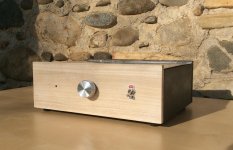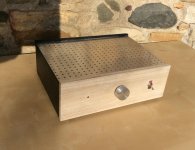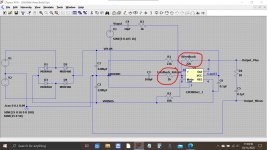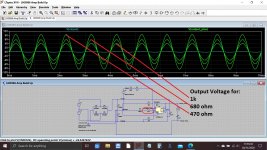Okay, I've duplicated everything for the RH channel, but I'm not getting any sound. I've measured the voltages across the pins and they are the same as the LH channel. Everything else 'looks' to be connected properly. Any suggestions of things I could check? LH is working fine as before.
If it is duplicated exactly then it should work 
Are all these the same? or are any different?:
If they are all the same then switch off and check the continuity of the negative speaker terminal back to the zero volt point. It should read as a 'short' meaning continuity.
Do the same for the positive speaker terminal measuring from the positive speaker terminal to pin 3 of the chip. Again there should be continuity.
Check that you have wired pin 10 (the input) in exactly the same way as the other channel and that it connects to the middle pin of the volume control via a similar series resistor and cap as the other channel.
Check that the end pins of the volume control are wired correctly and that there is continuity from the control to the input socket.
Make sure you haven't an accidental short across the input socket.
Are all these the same? or are any different?:
I've got: pin: 1 +27v, pin 3: 0 pin 4: -27v, pin 5: +27v, pin 7: 0, pin 8: -0.45, pin 9: 0, pin 10: 0
If they are all the same then switch off and check the continuity of the negative speaker terminal back to the zero volt point. It should read as a 'short' meaning continuity.
Do the same for the positive speaker terminal measuring from the positive speaker terminal to pin 3 of the chip. Again there should be continuity.
Check that you have wired pin 10 (the input) in exactly the same way as the other channel and that it connects to the middle pin of the volume control via a similar series resistor and cap as the other channel.
Check that the end pins of the volume control are wired correctly and that there is continuity from the control to the input socket.
Make sure you haven't an accidental short across the input socket.
Okay, I've duplicated everything for the RH channel, but I'm not getting any sound. I've measured the voltages across the pins and they are the same as the LH channel. Everything else 'looks' to be connected properly. Any suggestions of things I could check? LH is working fine as before.
You should check that you haven't been drinking too much of your finely crafted beer
I've started a micro-brewery - Brew your own! - Survive France
Shakespeare: Biere Artisanale
Last edited:
Ha! I think I've found the culprit. The potentiometer is either a bit faulty of I've damaged it somehow, but I can get both channels with sound if I wiggle it a bit  , but it doesn't seem to matter how much I turn the volume up, it stays the same. I suppose I'll just have to get another one or try my linear one and see if that works okay.
, but it doesn't seem to matter how much I turn the volume up, it stays the same. I suppose I'll just have to get another one or try my linear one and see if that works okay.
 wonderful. See, you got there in the end
wonderful. See, you got there in the end Differences... good ones should have better matching between the two gangs which means the stereo image stays put as you alter the volume control.
We can make your linear one into a log by just adding two resistors across two of the pins. In some ways a better solution than a log pot because linear pots tend to have better matching.
None more than me!I love a happy ending
Yes, same here! It’s been a while, but so worth it and I’ve learned so much. I don’t know whether I’d have tried it if it wasn’t for a lockdown, so every cloud....��. Also if Mooly hadn’t stepped in and helped me the way he did I would probably have given up. And I’m not going away yet either!
And I’m not going away yet either!..........
Oh heck, so what's next on the to do list
Here's what it looks like. It's in an mdf case with a perforated aluminium top and a wooden front. It sounds just SO good! I am slightly surprised I have to turn it up quite a way to get it loud, but there's no doubt the quality is there 
Attachments
That looks great  so there is no stopping you now
so there is no stopping you now 
There are two things to remember with 'having to turn it up quite a way'
First, that is an effect of using a linear rather than a log pot. It will start off OK and then you seem to have it turn it up lots to get any more volume. Ultimately both types give exactly the same levels, they just vary in their position on the dial for a given volume.
The addition of those two resistors I mentioned earlier (just soldered to the pins of the control) change the linear to a log type response.
Secondly, if you find that even on full volume it is not going loud enough then that means that the amplifier isn't sensitive enough for the source you are feeding it from.
You have two choices with that... either add a preamplifier or increase the gain of the circuit you have. Increasing the gain is easy...
The two resistors circled on the diagram set the voltage gain and it is calculated as (Rfeedback/Feed backreturn)+1
So we have (22000/1000) + 1 which is 23.
If you want a bit more gain then you could reduce the 1k a little to lets say 680 ohm. That would give a gain of (22000/680) + 1 which is 33.
I would advise you keep the 22k as it is so as to preserve the DC balance of the amplifier.
Do not make the 1k to low in value although even values down to 470 or even 330 ohm should be OK.
Also never make the 1k much higher (which would reduce gain) because the circuit relies and needs a minimum gain factor to be stable. Higher gain is often more stable and some argue actually sounds better because of the lower feedback factor.
If you change anything then always try it with the bulb first just to be sure all is OK.
There are two things to remember with 'having to turn it up quite a way'
First, that is an effect of using a linear rather than a log pot. It will start off OK and then you seem to have it turn it up lots to get any more volume. Ultimately both types give exactly the same levels, they just vary in their position on the dial for a given volume.
The addition of those two resistors I mentioned earlier (just soldered to the pins of the control) change the linear to a log type response.
Secondly, if you find that even on full volume it is not going loud enough then that means that the amplifier isn't sensitive enough for the source you are feeding it from.
You have two choices with that... either add a preamplifier or increase the gain of the circuit you have. Increasing the gain is easy...
The two resistors circled on the diagram set the voltage gain and it is calculated as (Rfeedback/Feed backreturn)+1
So we have (22000/1000) + 1 which is 23.
If you want a bit more gain then you could reduce the 1k a little to lets say 680 ohm. That would give a gain of (22000/680) + 1 which is 33.
I would advise you keep the 22k as it is so as to preserve the DC balance of the amplifier.
Do not make the 1k to low in value although even values down to 470 or even 330 ohm should be OK.
Also never make the 1k much higher (which would reduce gain) because the circuit relies and needs a minimum gain factor to be stable. Higher gain is often more stable and some argue actually sounds better because of the lower feedback factor.
If you change anything then always try it with the bulb first just to be sure all is OK.
Attachments
Here's what it looks like. It's in an mdf case with a perforated aluminium top and a wooden front. It sounds just SO good! I am slightly surprised I have to turn it up quite a way to get it loud, but there's no doubt the quality is there
Very nice.
- Home
- Amplifiers
- Chip Amps
- Complete novice alert! *don't read if easily annoyed by stupid questions*



